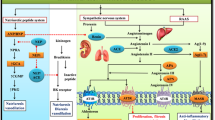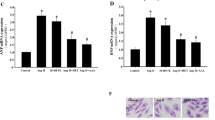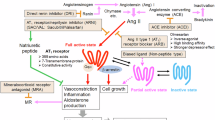Abstract
The aim of this study was to provide new insights into the role of angiotensin II and arterial pressure in the regulation of antioxidant enzyme activities in a renovascular model of cardiac hypertrophy. For this purpose, aortic coarcted rats were treated with losartan or minoxidil for 7 days. Angiotensin II induced cardiac hypertrophy and oxidative stress via Nox4, p22phox and p47phox, which are components of the NAD(P)H oxidase. Antioxidant enzymes were regulated by arterial pressure and were not implicated in cardiac hypertrophy. Heme oxygenase-1, the rate-limiting enzyme in heme catabolism, behaved as a catalase and glutathione peroxidase, and is regulated by arterial pressure. In summary, the present report indicates that cardiac hypertrophy, induced by renovascular hypertension, depends on angiotensin II through reactive oxygen species and is not prevented by the action of antioxidant enzymes.
Similar content being viewed by others
Article PDF
References
Sawyer DB, Siwik DA, Xiao L, Pimentel DR, Singh K, Colucci WS : Role of oxidative stress in myocardial hypertrophy and failure. J Mol Cell Cardiol 2002; 34: 379–388.
Tsu S, Touyz RM : Reactive oxygen species and vascular remodelling in hypertension: still alive. Can J Cardiol 2006; 22: 947–951.
Sowers JR : Hypertension, angiotensin II and oxidative stress. N Engl J Med 2002; 346: 1999–2001.
Touyz RM : Reactive oxygen species, vascular oxidative stress, and redox signaling in hypertension. What is the clinical significance? Hypertension 2004; 44: 248–252.
Touyz RM : Reactive oxygen species and angiotensin II signaling in vascular cells implications in cardiovascular disease. Braz J Med Biol Res 2004; 37: 1263–1273.
Tomaro ML, Batlle AMC : Bilirubin: its role in cytoprotection against oxidative stress. Int J Biochem Cel Biol 2002; 34: 216–220.
Kikuchi G, Yoshida T, Noguchi M : Heme oxygenase and heme degradation. Biochem Biophys Res Commum 2005; 338: 558–567.
Maines MD, Gibbs PEM : 30 some years of heme oxygenase: from a “molecular wrecking ball” to a “mesmerizing” trigger of cellular events. Biochem Biophys Res Commun 2005; 338: 568–577.
Maines MD : The heme oxygenase system: update 2005. Antiox Redox Signal 2005; 7: 1761–1766.
Sindhu RK, Roberts CK, Ehdaie A, Zhan CD, Vaziri ND : Effects of aortic coarctation on aortic antioxidant enzymes and NADPH oxidase protein expression. Life Sci 2005; 76: 945–953.
Gironacci MM, Brosnihan KB, Ferrario CM, et al: Increased hypothalamic angiotensin-(1–7) levels in rats with aortic coarctation–induced hypertension. Peptides 2007; 28: 1580–1585.
Lai FM, Herzlinger H, Cervoni P : A comparison of cardiac alpha-adrenoceptor number and affinity between aorta-coarcted hypertensive and normotensive rats. Res Commun Mol Pathol Pharmacol 1984; 43: 55–65.
Polizio AH, Gorzalczany S, Taira C, Peña C : Aortic coarctation induces oxidative stress in rat tissues. Life Sci 2006; 79: 596–600.
Baker KM, Chernin MI, Wixson SK, Aceto JF : Renin-angiotensin system involvement in pressure overload cardiac hypertrophy in rats. Am J Physiol 1990; 259: H324–H332.
Shimosawa T : Mechanical stress and humoral factors linked to the induction of oxidative stress. Hypertens Res 2006; 29: 643–644.
Ungvari Z, Csiszar A, Kaminski PM, Wolin MS, Koller A : Chronic high pressure–induced arterial oxidative stress. Involvement of protein kinase C–dependent NAD(P)H oxidase and local renin-angiotensin system. Am J Pathol 2004; 165: 219–226.
Paradis P, Dali-Youcef N, Paradis FW, Thibault G, Nemer M : Overexpression of angiotensin II type 1 receptor in cardiomyocytes induces cardiac hypertrophy and remodeling. Proc Natl Acad Sci U S A 2000; 97: 931–936.
Rojo-Ortega JM, Genest J : A method for production of experimental hypertension in rats. Can J Physiol Pharmacol 1968; 46: 883–885.
Chance B, Sies H, Boveris A : Hydroperoxide metabolism in mammalian organs. Physiol Rev 1979; 59: 527–605.
Flohé L, Gunzler WA : Assays of glutathione peroxidase. Meth Enzymol 1984; 105: 114–121.
Misra HP, Fridovich I : The role of superoxide anion in the autoxidation of epinephrine and a simple assay for superoxide dismutase. J Biol Chem 1972; 247: 3170–3175.
Anderson ME : Determination of glutathione and glutathione disulfide in biological samples. Meth Enzymol 1985; 113: 548–555.
Buege A, Aust SD : Microsomal lipid peroxidation. Meth Enzymol 1978; 52: 302–310.
Boveris A : Determination of the production of superoxide radicals and hydrogen peroxide in mitochondria. Meth Enzymol 1984; 105: 429–435.
Foresti R, Clark JE, Green CJ, Motterlini R : Thiol compounds interact with nitric oxide in regulating heme oxygenase-1 induction in endothelial cells. J Biol Chem 1997; 272: 18411–18417.
Ossola JO, Tomaro ML : Heme oxygenase induction by cadmium chloride: evidence for oxidative stress involvement. Toxicology 1995; 104: 141–147.
Llesuy SF, Tomaro ML : Heme oxygenase and oxidative stress. Evidence of involvement of bilirubin as physiological protector against oxidative damage. Biochim Biophys Acta 1994; 1223: 9–14.
Lowry HO, Rosebrough NJ, Farr AL, Randall RJ : Protein measurement with the Folin reagent. J Biol Chem 1951; 193: 265–275.
Griendling KK, Sorescu D, Ushio-Fukai M : NAD(P)H oxidase: role in cardiovascular biology and disease. Circ Res 2000; 86: 494–501.
Griendling KK, Ushio-Fukai M : Reactive oxygen species as mediators of angiotensin II signaling. Regul Peptides 2000; 91: 21–27.
Zafari AM, Ushio-Fukai M, Akers M, et al: Role of NADH/NADPH oxidase–derived H2O2 in angiotensin II induced vascular hypertrophy. Hypertension 1998; 32: 488–495.
Zhang Y, Griendling KK, Dikalova A, Owens GK, Taylor WR : Vascular hypertrophy in angiotensin II–induced hypertension is mediated by vascular smooth muscle cell–derived H2O2 . Hypertension 2005; 46: 732–737.
Ushio-Fukai M, Alexander RW, Akers M, Griendling KK : p38 mitogen-activated protein kinase is a critical component of the redox-sensitive signaling pathways activated by angiotensin II. Role in vascular smooth muscle cell hypertrophy. J Biol Chem 1998; 273: 15022–15029.
Ushio-Fukai M, Alexander RW, Akers M, et al: Reactive oxygen species mediate the activation of Akt/ protein kinase B by angiotensin II in vascular smooth muscle cells. J Biol Chem 1999; 274: 22699–22704.
Byrne JA, Grieve DJ, Bendall JK, et al: Contrasting roles of NADPH oxidase isoforms in pressure-overload versus angiotensin II–induced cardiac hypertrophy. Circ Res 2003; 93: 802–804.
Maytin M, Siwik DA, Ito M, et al: Pressure overload–induced myocardial hypertrophy in mice does not require gp91phox. Circulation 2004; 109: 1168–1171.
Takai S, Kirimura K, Jin D, et al: Significance of angiotensin II receptor blocker. lipophilicities and their protective effect against vascular remodeling. Hypertens Res 2005; 28: 593–600.
Tsilimingas N, Walter U, Förstermann U, et al: Effects of angiotensin II infusionon the expression and function of NAD(P)H oxidase and components of nitric Oxide/cGMP signaling. Circ Res 2002; 90: 58–65.
Johnson P : Antioxidant enzyme expression in health and disease: effects of exercise and hypertension. Comp Biochem Physiol C 2002; 133: 493–505.
Polizio AH, Peña C : Effects of angiotensin II type 1 receptor blockade on the oxidative stress in spontaneously hypertensive rat tissues. Regul Peptides 2005; 128: 1–5.
Vogt M, Bauer MKA, Ferrari D, Schulze-Osthoff K : Oxidative stress and hypoxia/reoxygenation trigger CD95 (APO-1/Fas) ligand expression in microglial cells. FEBS Lett 1998; 429: 67–72.
Csonka C, Pataki T, Kovacs P, et al: Effects of oxidative stress on the expression of antioxidative defense enzymes in spontaneously hypertensive rat hearts. Free Radic Biol Med 2000; 29: 612–619.
Binda D, Nicod L, Viollon-Abadie C : Strain difference (WKY, SPRD) in the hepatic antioxidant status in rat and effect of hypertension (SHR, DOCA). Ex vivo and in vitro data. Mol Cell Biochem 2001; 218: 139–146.
Author information
Authors and Affiliations
Corresponding author
Rights and permissions
About this article
Cite this article
Polizio, A., Balestrasse, K., Yannarelli, G. et al. Angiotensin II Regulates Cardiac Hypertrophy via Oxidative Stress but Not Antioxidant Enzyme Activities in Experimental Renovascular Hypertension. Hypertens Res 31, 325–334 (2008). https://doi.org/10.1291/hypres.31.325
Received:
Accepted:
Issue date:
DOI: https://doi.org/10.1291/hypres.31.325
Keywords
This article is cited by
-
Ellagic Acid Prevents Ca2+ Dysregulation and Improves Functional Abnormalities of Ventricular Myocytes via Attenuation of Oxidative Stress in Pathological Cardiac Hypertrophy
Cardiovascular Toxicology (2021)
-
Evolving concepts in the pathogenesis of uraemic cardiomyopathy
Nature Reviews Nephrology (2019)
-
Puerarin-7-O-glucuronide, a water-soluble puerarin metabolite, prevents angiotensin II-induced cardiomyocyte hypertrophy by reducing oxidative stress
Naunyn-Schmiedeberg's Archives of Pharmacology (2017)
-
Reduction of Rat Cardiac Hypertrophy by Osthol is Related to Regulation of Cardiac Oxidative Stress and Lipid Metabolism
Lipids (2012)



